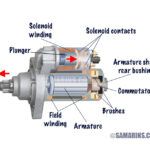
Ford Puma Battery Problems — Symptoms, Causes, and Fixes

The Ford Puma, renowned for its sporty design and efficiency, is not immune to electrical issues — particularly battery-related problems. When your Puma refuses to start, displays warning lights, or its electronics act erratically, the battery may be the culprit. In this comprehensive guide, we detail the most common Ford Puma battery problems, their symptoms, root causes, and practical solutions to keep your crossover running flawlessly.
⚠️ Key Symptoms of Battery Problems in the Ford Puma
1. Engine Struggles or Fails to Start
A slow crank or clicking noise when turning the key usually points to a weak or discharged battery. If the starter motor sounds labored or doesn’t engage at all, your battery might be at the end of its service life.
2. Dimming or Flickering Lights
When headlights, dashboard lights, or interior lamps appear dim or pulsating, it indicates insufficient voltage supply. This symptom is often noticeable when idling or using multiple accessories simultaneously.
3. Battery Warning Light on the Dashboard
If the battery icon illuminates on your Ford Puma’s dashboard, it means the charging system isn’t working properly — either due to a dying battery, faulty alternator, or bad voltage regulator.
4. Strange Sulfur Smell
A rotten egg odor under the hood often means the battery is overheating or leaking acid, typically caused by internal short circuits or overcharging. This issue should be addressed immediately, as it poses a safety hazard.
5. Corrosion on Battery Terminals
White or green residue around the terminals signals corrosion, which restricts current flow. This leads to erratic electrical behavior and prevents the alternator from charging the battery properly.
6. Aging Battery
Most car batteries last 3–5 years. If your Puma’s battery is older than four years and showing symptoms like slow starts or electrical resets, replacement is recommended.
7. Malfunctioning Electrical Accessories
When your radio, air conditioning, or wipers behave unpredictably, it may be due to low voltage. A weak battery struggles to support all electrical systems, especially under high load.
You may be interested in reading Ford Puma Clicking Noise and Won’t Start – Complete Troubleshooting Guide
Ford Puma Clicking Noise and Won’t Start – Complete Troubleshooting Guide8. System Resets and Electronic Failures
Spontaneous resets of the infotainment or navigation system, or flickering dashboard displays, often stem from inconsistent power delivery — another clear sign of a weak or dying battery.
🧠 Causes of Battery Issues in the Ford Puma
1. Battery Drain or Discharge
Leaving lights on, charging devices overnight, or running the radio with the engine off can drain the battery quickly. Extreme temperatures worsen this effect.
Solution:
Jump-start the vehicle and have the battery tested at a garage. If the charge drops again after driving, the problem could lie in the alternator.
2. Old or Damaged Battery
Batteries deteriorate naturally over time. Repeated deep discharges, vibration, or excessive heat accelerate wear.
Solution:
Replace the battery every 4–5 years. Choose a high-quality, OEM-compatible battery rated for your Puma’s electrical system (typically a 12V 60Ah–70Ah AGM type).
3. Poor Terminal Connections
Loose, corroded, or damaged terminals prevent proper current flow between the battery and vehicle systems.
Solution:
Clean terminals using a mixture of baking soda and water, tighten connections securely, and apply dielectric grease to prevent future corrosion.
4. Faulty Alternator
The alternator recharges the battery while driving. A defective alternator can lead to rapid battery discharge and cause the warning light to appear.
You may be interested in reading Ford Puma Clicking Noise and Won’t Start – Complete Troubleshooting Guide
Ford Puma Clicking Noise and Won’t Start – Complete Troubleshooting Guide Common Ford Puma Problems and How to Fix Them
Common Ford Puma Problems and How to Fix ThemSolution:
Have a mechanic check the alternator’s output voltage (should be around 13.8–14.5V). Replace if it fails to maintain proper charging levels.
5. Electrical Overload
Defective electrical accessories can draw excessive current, draining the battery even when the engine is off.
Solution:
Perform a parasitic draw test to locate the faulty circuit. Disconnect malfunctioning accessories or have them repaired.
6. Extreme Weather
Cold reduces battery capacity, while high heat damages internal components and evaporates electrolytes.
Solution:
Use heat-resistant or cold-cranking rated batteries suitable for your climate. Park indoors when possible.
7. Short Circuits or Wiring Faults
Faulty wiring, especially in the charging or grounding circuits, can cause voltage drops and battery drain.
Solution:
Request a comprehensive electrical diagnostic to check for grounding issues, damaged fuses, or frayed wires.
🔧 Causes and Solutions Overview
| Cause | Description | Recommended Solution |
|---|---|---|
| Battery Discharge | Lights or accessories left on, parasitic drain | Jump-start or recharge battery |
| Aged Battery | Reduced capacity after 3–5 years | Replace with OEM-rated unit |
| Corroded Terminals | Poor contact from oxidation | Clean and tighten connections |
| Faulty Alternator | Insufficient charging voltage | Test and replace alternator |
| Electrical Overload | Malfunctioning accessories | Diagnose and repair wiring |
| Extreme Temperatures | Heat or cold affecting performance | Use climate-appropriate battery |
| Short Circuits | Damaged cables or fuses | Inspect and repair wiring |
🔋 Battery Replacement Tips for Ford Puma
- Battery Type: 12V 60Ah (AGM recommended for start-stop models)
- Cold Cranking Amps (CCA): 540–700A
- Location: Under the hood, near the driver’s side strut tower
- Tools Needed: 10mm wrench, terminal cleaner, protective gloves
- Procedure Summary:
- Turn off ignition and remove the key.
- Disconnect the negative terminal first, then the positive.
- Remove the clamp and lift the old battery carefully.
- Install the new battery and reconnect terminals (positive first).
- Reset electrical systems if necessary.
📊 Battery Maintenance Checklist
| Task | Frequency | Purpose |
|---|---|---|
| Check battery terminals | Every 3 months | Detect corrosion early |
| Measure voltage | Monthly | Monitor battery health |
| Clean battery top | Quarterly | Prevent current leakage |
| Replace battery | Every 4–5 years | Avoid sudden failure |
| Inspect alternator belt | Annually | Ensure proper charging |
🔎 Recall Information and Known Issues
- Recall 2020: Ford issued a recall for certain Puma models due to an alternator software defect causing premature battery discharge.
- Terminal Faults: Some early production units experienced loose battery connectors, prompting Ford to provide free inspections and replacements.
- Software Updates: In later models, Ford released firmware updates to improve charging control logic and prevent overcharging.
🧭 Proactive Maintenance Tips
- Avoid leaving devices plugged in when the engine is off.
- Turn off all lights before exiting the vehicle.
- Regularly inspect the alternator belt and voltage output.
- Use a battery maintainer if the car remains parked for long periods.
- Park in shaded or covered areas to reduce heat exposure.
✅ Final Thoughts
Maintaining a healthy battery in your Ford Puma is essential for reliability and performance. By paying attention to early warning signs, addressing connection or alternator issues, and performing routine inspections, you can prevent unexpected breakdowns and extend the lifespan of your vehicle’s electrical system.
You may be interested in reading Ford Puma Clicking Noise and Won’t Start – Complete Troubleshooting Guide
Ford Puma Clicking Noise and Won’t Start – Complete Troubleshooting Guide Common Ford Puma Problems and How to Fix Them
Common Ford Puma Problems and How to Fix Them Ford Puma Automatic Transmission Problems: Common Issues, Causes, and Fixes
Ford Puma Automatic Transmission Problems: Common Issues, Causes, and FixesIf you want to know other articles similar to Ford Puma Battery Problems — Symptoms, Causes, and Fixes you can visit the category Common Problems.
Deja una respuesta






More content of your interest